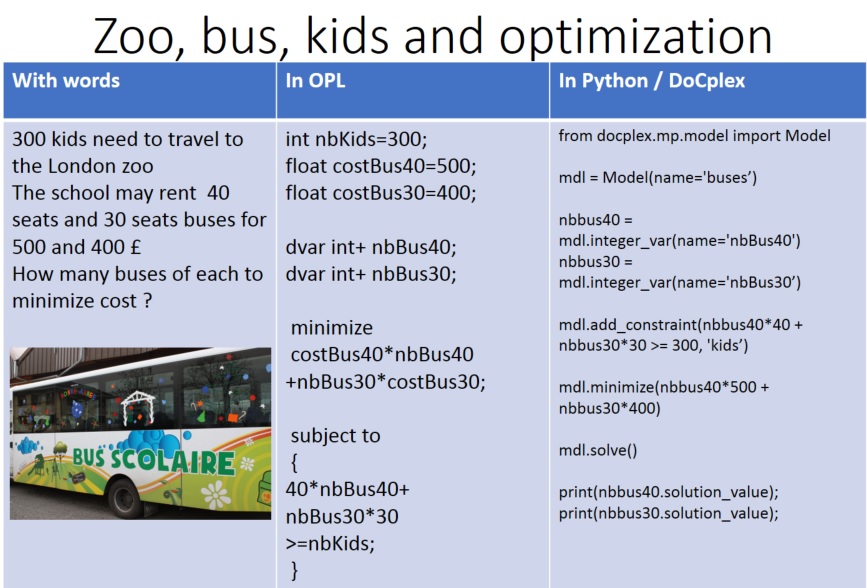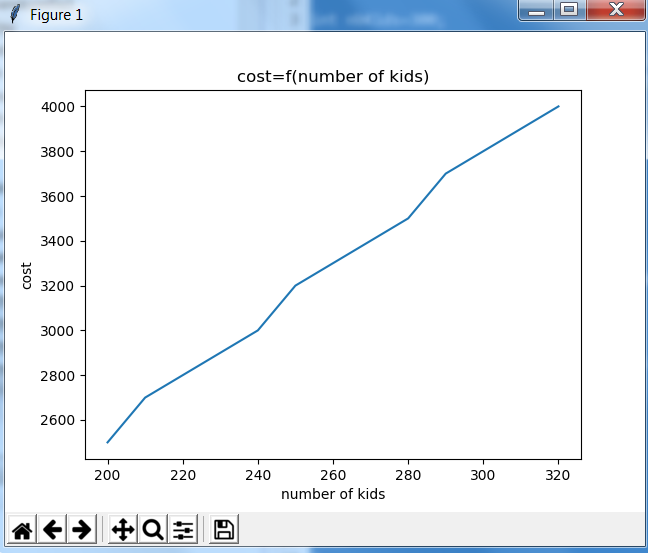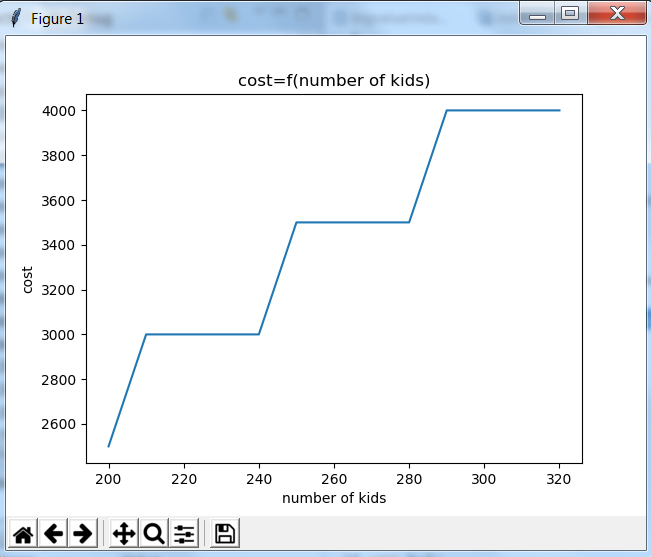Hi,
let us go on with https://www.linkedin.com/pulse/what-optimization-how-can-help-you-do-more-less-zoo-buses-fleischer/

but now we need to know how the cost will change when we change the number of kids from 200 to 320 because there may be a flu and some additional visiting kids.
To do that you could use a main block in OPL :
int nbKids=300;
{int} nbKidsOptions={nbKids+i*10 | i in -10..2};
float costBus40=500;
float costBus30=400;
dvar int+ nbBus40;
dvar int+ nbBus30;
minimize
costBus40*nbBus40 +nbBus30*costBus30;
subject to
{
ctKids:40*nbBus40+nbBus30*30>=nbKids;
}
execute
{
writeln("nbBus40 = ",nbBus40);
writeln("nbBus30 = ",nbBus30);
}
main
{
thisOplModel.generate();
for(var nbKids in thisOplModel.nbKidsOptions)
{
writeln("if we need to bring ",nbKids," kids to the zoo");
thisOplModel.ctKids.LB=nbKids;
cplex.solve();
thisOplModel.postProcess();
writeln("And the cost is ",cplex.getObjValue());
writeln();
}
}
and you will get
if we need to bring 200 kids to the zoo
nbBus40 = 5
nbBus30 = 0
And the cost is 2500
if we need to bring 210 kids to the zoo
nbBus40 = 3
nbBus30 = 3
And the cost is 2700
if we need to bring 220 kids to the zoo
nbBus40 = 4
nbBus30 = 2
And the cost is 2800
if we need to bring 230 kids to the zoo
nbBus40 = 5
nbBus30 = 1
And the cost is 2900
if we need to bring 240 kids to the zoo
nbBus40 = 6
nbBus30 = 0
And the cost is 3000
if we need to bring 250 kids to the zoo
nbBus40 = 4
nbBus30 = 3
And the cost is 3200
if we need to bring 260 kids to the zoo
nbBus40 = 5
nbBus30 = 2
And the cost is 3300
if we need to bring 270 kids to the zoo
nbBus40 = 6
nbBus30 = 1
And the cost is 3400
if we need to bring 280 kids to the zoo
nbBus40 = 7
nbBus30 = 0
And the cost is 3500
if we need to bring 290 kids to the zoo
nbBus40 = 5
nbBus30 = 3
And the cost is 3700
if we need to bring 300 kids to the zoo
nbBus40 = 6
nbBus30 = 2
And the cost is 3800
if we need to bring 310 kids to the zoo
nbBus40 = 7
nbBus30 = 1
And the cost is 3900
if we need to bring 320 kids to the zoo
nbBus40 = 8
nbBus30 = 0
And the cost is 4000
which is nice but would be even better in a graph.
Then we could use visu.mod
execute
{
// turn an OPL array into a python list
function getPythonListOfArray(_array)
{
var quote="\"";
var nextline="\\\n";
var res="[";
for(var i in _array)
{
var value=_array[i];
if (typeof(value)=="string") res+=quote;
res+=value;
if (typeof(value)=="string") res+=quote;
res+=",";
res+=nextline;
}
res+="]";
return res;
}
// Display a function with points with x and y arrays of x and y
function displayXY(x,y,pythonpath,pythonfile,graphName,xName,yName)
{
writeln("displayXY ",x," ",y," ",pythonpath," ",pythonfile);
var python=new IloOplOutputFile(pythonfile);
python.writeln("import matplotlib.pyplot as plt");
python.writeln("x = ",getPythonListOfArray(x))
python.writeln("y = ",getPythonListOfArray(y))
python.writeln("plt.plot(x, y)");
python.writeln("plt.xlabel('",xName,"')");
python.writeln("plt.ylabel('",yName,"')");
python.writeln("plt.title('",graphName,"')");
python.writeln("plt.show()");
python.close();
IloOplExec(pythonpath+" "+ pythonfile,true);
}
}
and then
include "visu.mod";
int nbKids=300;
{int} nbKidsOptions={nbKids+i*10 | i in -10..2};
int x2[i in 1..card(nbKidsOptions)]=item(nbKidsOptions,i-1);
int y2[i in 1..card(nbKidsOptions)];
float costBus40=500;
float costBus30=400;
dvar int+ nbBus40;
dvar int+ nbBus30;
minimize
costBus40*nbBus40 +nbBus30*costBus30;
subject to
{
ctKids:40*nbBus40+nbBus30*30>=nbKids;
}
execute
{
writeln("nbBus40 = ",nbBus40);
writeln("nbBus30 = ",nbBus30);
}
main
{
thisOplModel.generate();
var k=1;
for(var nbKids in thisOplModel.nbKidsOptions)
{
writeln("if we need to bring ",nbKids," kids to the zoo");
thisOplModel.ctKids.LB=nbKids;
cplex.solve();
thisOplModel.postProcess();
writeln("And the cost is ",cplex.getObjValue());
thisOplModel.y2[k]=cplex.getObjValue();
k++;
writeln();
}
var pythonpath="C:\\Users\\IBM_ADMIN\\AppData\\Local\\Programs\\Python\\Python36\\python.exe";
var pythonfile="C:\\displayXY.py";
displayXY(thisOplModel.x2,thisOplModel.y2,pythonpath,pythonfile,"cost=f(number of kids)","number of kids","cost");
}
gives

and which helps to see how 30 seats buses help. If we add an additional constraint
nbBus30==0; // No 30 seats buses
then we get

which is not a big surprise.
regards
#DecisionOptimization#OPLusingCPLEXOptimizer